A 3,000-year-old city wrecked by militants, left for looters
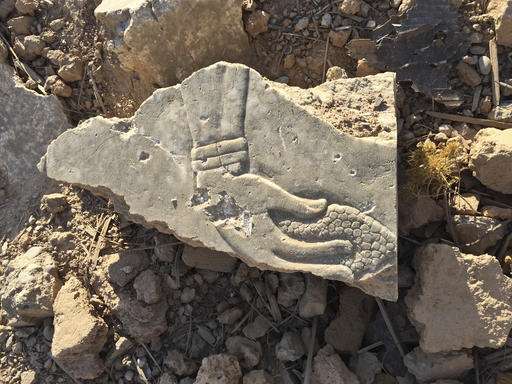
The giant winged bulls that once stood sentry at the nearly 3,000-year-old palace at Nimrud have been hacked to pieces. The fantastical human-headed creatures were believed to guard the king from evil, but now their stone remains are piled in the dirt, victims of the Islamic State group's fervor to erase history.
The militants' fanaticism devastated one of the most important archaeological sites in the Middle East. But more than a month after the militants were driven out, Nimrud is still being ravaged, its treasures disappearing, piece by piece, imperiling any chance of eventually rebuilding it, an Associated Press team found after multiple visits last month.
With the government and military still absorbed in fighting the war against the Islamic State group in the nearby city of Mosul, the wreckage of the Assyrian Empire's ancient capital lies unprotected and vulnerable to looters.
No one is assigned to guard the sprawling site, much less catalog the fragments of ancient reliefs, chunks of cuneiform texts, pieces of statues and other rubble after IS blew up nearly every structure there. Toppled stone slabs bearing a relief from the palace wall that the AP saw on one visit were gone when journalists returned.
"When I heard about Nimrud, my heart wept before my eyes did," said Hiba Hazim Hamad, an archaeology professor in Mosul who often took her students there. "My family and neighbors came to my house to pay condolences."
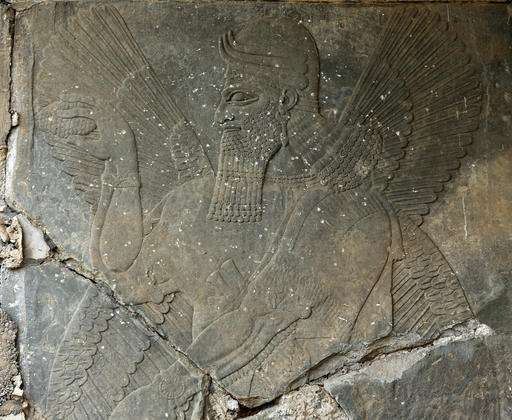
Perhaps the only vigilant guardian left for the ruins is an Iraqi archaeologist, Layla Salih. She has visited it multiple times in recent weeks, photographing the destruction to document it and badgering nearby militias to take care of it. Walking with the AP across the broad dirt expanse of the ruin, she was calm, methodical and precise as she pointed out things she'd seen on previous visits that were no longer in place.
Still, Salih does not despair. She searches out reasons for optimism.
"The good thing is the rubble is still in situ," she said. "The site is restorable."
To an untrained eye, that's hard to imagine, seeing the extent of the destruction that the Islamic State group wreaked in March 2015. Salih estimated that 60 percent of the site was irrecoverable.
The site's various structures—several palaces and temples—are spread over 360 hectares (900 acres) on a dirt plateau. A 140-foot-high ziggurat, or step pyramid, once arrested the gaze of anyone entering Nimrud. Where it stood, there is now only lumpy earth. Just past it, in the palace of King Ashurnasirpal II, walls are toppled, bricks spilled into giant piles. The palace's great courtyard is a field of cratered earth. Chunks of cuneiform writing are jammed in the dirt. Reliefs that once displayed gods and mythical creatures are reduced to random chunks showing a hand or a few feathers of a genie's wing.
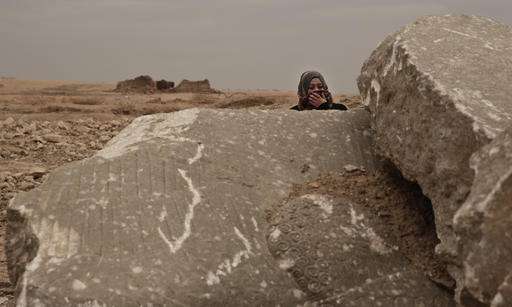
During a Dec. 14 assessment tour by UNESCO, a U.N. demining expert peered at a hole leading to a tomb that appeared to be intact. It might be rigged to explode, the expert said, and the UNESCO crew backed away.
The militants boasted of the destruction in high-definition video propaganda, touting their campaign to purge their self-declared "caliphate" of anything they deemed pagan or heretical.
They dismantled the winged bulls, known as lamassu, as purposefully as any decapitation they carried out in in Mosul or the Syrian city of Raqqa. The bearded male heads of the statues are missing—likely taken to be sold on the black market as IS has done with other artifacts. They then wired the entire palace with explosives and blew it apart, along with the temples of Nabu and of the goddess Ishtar.
It was a brutal blow to a site that gave the world a wealth of startling Mesopotamian art and deepened knowledge about the ancient Mideast.
Nimrud was a capital of the Assyrians, one the ancient world's earliest and most ferocious empires. Known at the time as Kalhu, the city was the seat of power from 879-709 BC, an era when Assyrian armies expanded out across the Levant, capturing Damascus and other cities, crushing the kingdom of Israel and turning its neighbor Judah into a vassal.
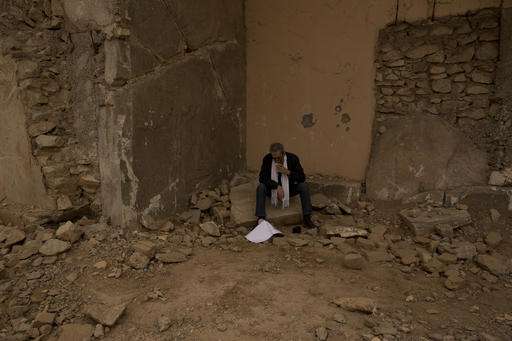
A British-Assyrian team first excavated Nimrud in 1945, then it was re-excavated in the 1950s by Max Mallowan. Though famous in his own right at the time, Mallowan is better known as the husband of Agatha Christie , who accompanied him and photographed and filmed the digs.
"It's just one of the most beautiful sites in the Middle East, or at least it was," said Georgina Herrmann, a British archaeologist who worked at Nimrud with Mallowan. "It used to be covered with wildflowers. You'd be there and there'd be bits of ancient sculptures sticking out."
Besides the reliefs and statues, archaeologists dug up hundreds of stone tablets written in cuneiform letters containing everything from treaties to temple and palace records. The tombs of queens yielded troves of gold and jewelry. Iraqi archaeologists also made a grisly find: more than 100 skeletons inside a palace well, including some with shackled hands and feet, possibly prisoners dumped in when Nimrud was sacked in 610 BC.
Salih, 40, came to Nimrud a few days after IS fighters were driven out in early November. So far, she is the only Iraqi antiquities official to visit. Ancient Assyria is not even Salih's field; she specialized in Islamic art and architecture. But there was no one else to do it. Half of the 50-odd government archaeologists in Mosul are still trapped there under IS rule.
She confirmed what satellite images had already shown: sometime between Sept. 1 and Nov. 4 as international forces closed in, IS bulldozed the ziggurat.
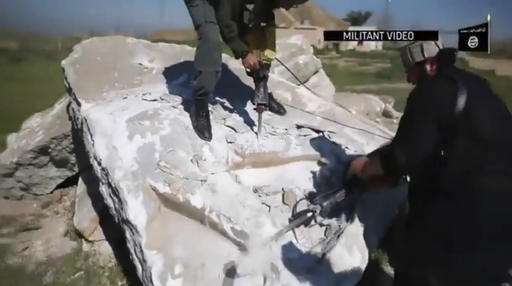
It had never been explored by archaeologists. "What exactly was inside it only ISIS knows," said Herrmann, using another acronym for the Islamic state group.
Touring the site, UNESCO's representative to Iraq, Louise Haxthausen, called the destruction "absolutely devastating."
"The most important thing right now is to ensure some basic protection," she said.
But the government has many priorities right now. It is still fighting IS in Mosul. Moreover, there is a long and expensive list of needs in rebuilding the country from the Islamic State group's legacy. Tens of thousands of citizens live in camps. Large swaths of the western city of Ramadi were destroyed in the offensive to wrest it from IS control. Mass graves are unearthed nearly every day in former IS territory, with more than 70 discovered already. Other ancient sites remain under IS control, including Nineveh—another ancient Assyrian capital—in the heart of Mosul.
Nimrud is in an active war zone, on the edge of the Tigris River valley south of Mosul. To reach it, one drives through checkpoints of multiple armed groups fighting IS—the Iraqi military, Shiite militias, Kurdish peshmerga and Christian fighters.

None of those forces is assigned to guard Nimrud. The first three times the AP visited, Sunni and Shiite fighters eventually showed up after an hour, apparently after hearing of the team's presence.
During the UNESCO tour, Salih noticed that some of the ancient bricks from the palace rubble had been neatly piled up as if to be hauled away. She questioned two Shiite militiamen about them.
"Both of them told me different stories," she said in exasperation. One said Islamic State extremists did it, intending to sell the bricks; the other said the militia members themselves stacked them to protect them. Salih believes neither story and thinks someone had hoped to take the bricks to repair homes damaged in fighting.
It's hard to say what's missing, because no one even knows what's in the piles of rubble to know if it's being stolen.
Two locals were recently arrested with a marble tablet and stone seal from Nimrud, presumably to sell. The men remain in custody.
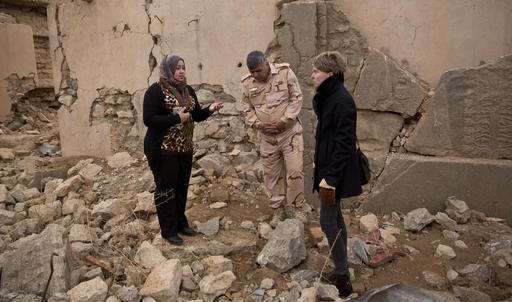
The artifacts seized from them, however, are harder to track down. The police insisted they were at a lab in Irbil, the capital of the Kurdish region in northern Iraq. The lab said it knew nothing about them. The Antiquities Ministry in Baghdad said they were safe in the Ninevah government offices, while an official in those offices said they were with the police awaiting transit to Baghdad.
It was a perfect circle of confusion—one that makes it easy for someone to simply steal items.
Salih is working to get international funding to pay someone to guard the site. But she recognizes that job will have to go to one of the militia factions. She has no illusions that the militias will provide full protection.
But she has grown used to compromises that once would have been unimaginable. Before she fled her home in Mosul soon after the IS takeover in 2014, she and other archaeologists pleaded with the militants to let them destroy the city's ancient tombs that the group so despised. At least that way, the buildings housing the tombs could be spared.
The plea was futile, and IS detonated the buildings and tombs.
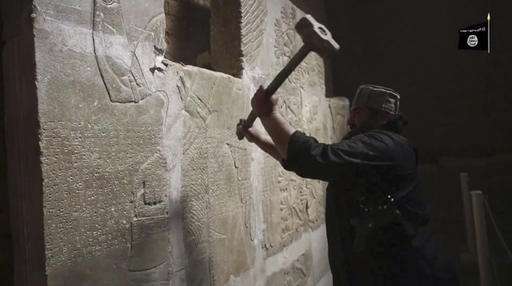
So she will negotiate now with the militias to do as much as they can to preserve Nimrud. On the final visit with the AP, wind-whipped winter rains sent rivulets of water through the loose dirt, further dislodging the remains.
"There isn't another choice, as you see," she said.
-
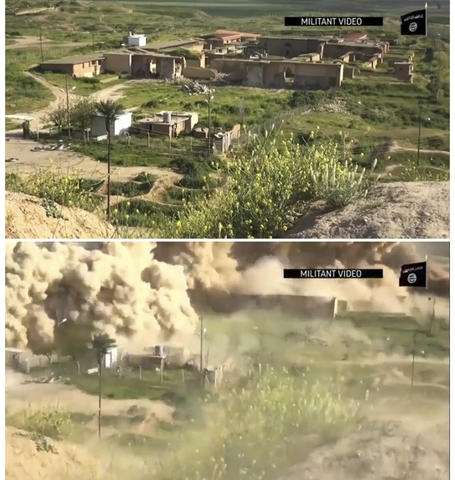
This image made from video posted online by Islamic State militants in April, 2015 shows the ancient site of Nimrud near Mosul, Iraq before and after militants exploded the site. One of the Mideast's most important archaeological sites, the nearly 3,000-year-old remains of an Assyrian capital had been a trove of ancient Mesopotamian art and, with hundreds of clay tablets, provided archaeologists a wealth of information on the era. (Militant video via AP) -
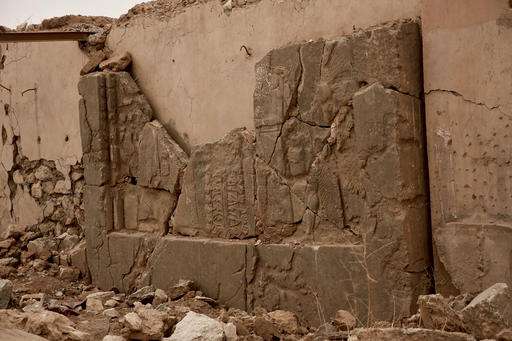
An ancient relief lies shattered in the Northwest Palace at the nearly 3,000-year-old site of Nimrud, Iraq, in this Wednesday, Dec. 14, 2016 photo. The destruction wreaked by Islamic State group militants at the site was extensive, leaving chunks of ancient reliefs, pieces of statues and pieces of cuneiform writing strewn amid rubble and dirt. With no protection more than a month after IS was driven out, those pieces are vulnerable to looting.(AP Photo/Maya Alleruzzo) -
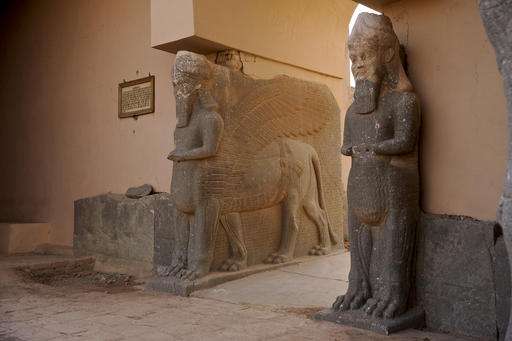
This Nov. 19, 2008 photo released by the U.S. Army shows the statues of the lamassu, the winged, human-headed bulls that stood at the gates of the palace and were believed to ward off evil in the ancient city of Nimrud, near Mosul, Iraq. The bulls were destroyed by Islamic State group militants in early 2015 as they razed the entire site, one of the most important archaeological ruins in the Middle East. (Staff Sgt. JoAnn S. Makinano, U.S. Army via AP) -
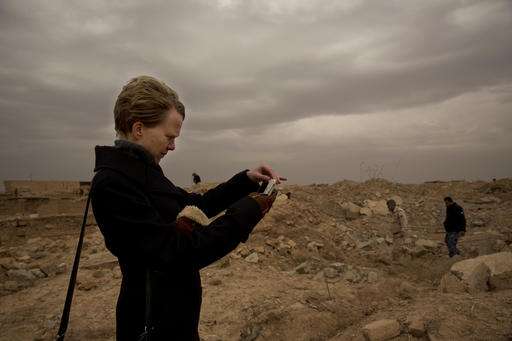
UNESCO's Iraq representative Louise Haxthausen documents the damage wreaked by the Islamic State group at the ancient site of Nimrud, Iraq, in this Wednesday, Dec. 14, 2016 photo. More than a month after the extremists were driven out, the site is still in danger, with the wreckage unprotected and vulnerable to being stolen. (AP Photo/Maya Alleruzzo) -
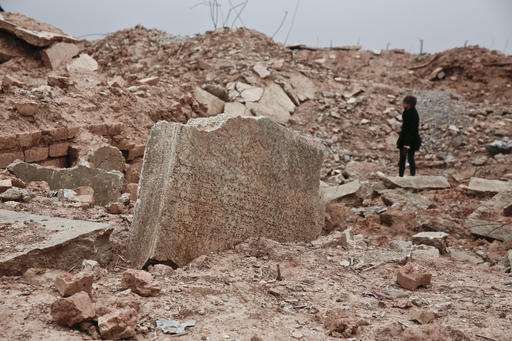
A stone tablet with cuneiform writing is seen in the foreground as UNESCO's Iraq representative Louise Haxthausen documents the damage wreaked by the Islamic State group at the ancient site of Nimrud, Iraq in this Wednesday, Dec. 14, 2016 photo. One of the Mideast's most important archaeological sites, the nearly 3,000-year-old remains of an Assyrian capital had been a trove of ancient Mesopotamian art and, with hundreds of clay tablets, provided archaeologists a wealth of information on the era. (AP Photo/Maya Alleruzzo) -
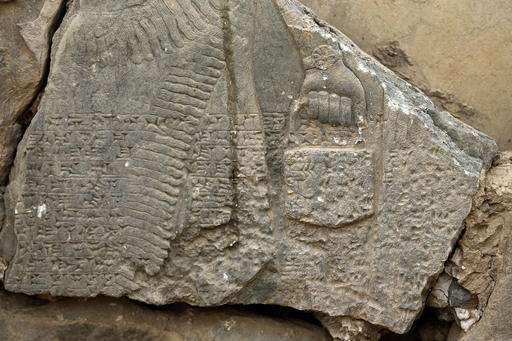
This Wednesday, Nov. 16, 2016 file photo shows a part of carved stone slabs which were destroyed by Islamic State group militants, at the ancient site of Nimrud some 19 miles (30 kilometers) southeast of Mosul, Iraq. One of the Mideast's most important archaeological sites, the nearly 3,000-year-old remains of an Assyrian capital had been a trove of ancient Mesopotamian art and, with hundreds of clay tablets, provided archaeologists a wealth of information on the era. (AP Photo/Hussein Malla, File) -
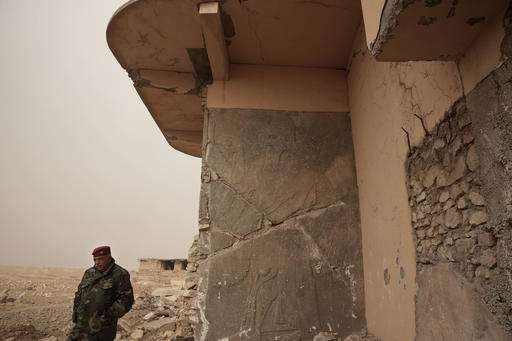
An Iraqi Army general stands near a stone slab depicting a winged genie at the entrance to the Northwest Palace at the ancient site of Nimrud, Iraq in this Wednesday, Dec. 14, 2016 photo. The Islamic State group militants who destroyed the remains of the nearly 3,000-year-old city have been driven away. But with the war still raging nearby, no one has been assigned to guard the site and the wreckage strewn around it is vulnerable to looting. (AP Photo/Maya Alleruzzo)
© 2017 The Associated Press. All rights reserved.



















